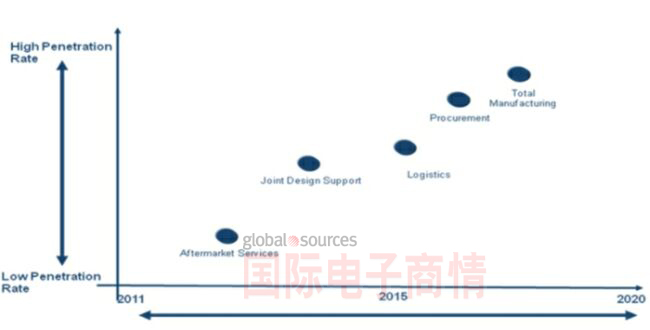關鍵字:EMS 可再生能源
因此,在可再生能源與智能電網(wǎng)市場,來自OEM廠商的外包機會正在增加。
OEM的外包趨勢
由于OEM廠商面臨價格壓力,他們對于EMS供應商的依賴性預計穩(wěn)步上升。EMS提供商改善流程控制并具備專業(yè)制造技術,可以為OEM廠商帶來成本效益,這將是讓EMS提供商在可再生能源與智能電網(wǎng)市場增強地位的主要優(yōu)勢。
OEM廠商也需要在管理產(chǎn)量的動態(tài)變化與及時向市場推出產(chǎn)品方面得到支持。市場對于太陽能面板的需求增長,要求OEM廠商擴大產(chǎn)能。OEM廠商試圖涉足全球市場,而EMS提供商的全球化布局正在為尋求利用環(huán)保趨勢的設備生產(chǎn)商創(chuàng)造機會。

這種情況使EMS提供商處于有利位置。電子產(chǎn)業(yè)充分了解合同制造的好處。EMS提供商在各服務領域所具備的實力——從設計支持到分銷,克服了許多進入阻礙。
權衡成功因素
預計可再生能源與智能電網(wǎng)市場將追隨其它垂直市場,把業(yè)務外包給EMS提供商。雖然創(chuàng)造額外營業(yè)收入的潛力確實存在,但問題是這種潛力會有多大呢?
在可再生能源領域,EMS市場的復合年度增長率預計為15-20%。然而,來自可再生能源的EMS市場營業(yè)收入預計仍將大大低于消費電子領域或電信市場。
但對于多數(shù)EMS提供商來說,在多元化戰(zhàn)略與降低風險方面,可再生能源與智能電網(wǎng)將扮演關鍵角色。
不是所有的EMS提供商都能在可再生能源市場獲得可觀的份額。從制造能力、進入具有成本競爭力的市場以及價格競爭能力等方面來看,一線EMS提供商比小型同業(yè)具有明顯優(yōu)勢。對于許多有心嘗試的EMS提供商來說,關鍵問題是:
•進入策略將以什么為中心?如果這種策略基于價格,那么廠商是否具備支持新策略所需的財務穩(wěn)定性?
•長期來看,多元化是否會提供一個可持續(xù)的成長平臺?
•多元化是否能補充企業(yè)策略和商業(yè)模式?
•誰是直接競爭對手?
EMS提供商要想成功,必須透徹理解可再生能源的商業(yè)環(huán)境。其中一個方面是,該行業(yè)非常依賴政府的支持。滲透可再生能源市場,將要求EMS提供商拓寬產(chǎn)品與服務范圍,并通過改善溝通來提高其能見度。
可再生能源與智能電網(wǎng)市場在不斷發(fā)展變化。隨著預算限制增強,OEM廠商將考慮通過與EMS提供商結成戰(zhàn)略聯(lián)盟來提高競爭力。因此,可再生能源將繼續(xù)為電子制造商提供更多機會。對于EMS提供商來說,成功取決于其執(zhí)行力。贏家將是能夠抓住新能源機會的廠商,而且他們能向OEM伙伴在這些新興市場提供具體的好處。
Next growth market for EMS providers: renewable energy
Lavanya Rammohan
Increasing focus on renewable energy and environmental awareness are creating growth opportunities for electronics manufacturing service (EMS) providers. More electronics manufacturers are broadening their product portfolios to penetrate renewable energy and smart grid markets. With competition shaping the EMS business model, the ability to pursue and sustain growth opportunities will be crucial for success. Key factors such as operational efficiency, competitive cost structures, strategic growth and geographic expansion will remain the primary drivers for outsourcing from OEMs.
As a result, outsourcing opportunities from OEMs in renewable energy and smart grid markets are gaining momentum.
OEM outsourcing trend
As OEMs contend with price pressures, their dependence on EMS providers is expected to increase steadily. The cost benefits derived from EMS providers’ improved process control and manufacturing expertise will remain a primary driver for increasing the role of EMS providers in the renewable energy and smart grid markets.
OEMs also require support to manage the dynamics of fluctuating manufacturing volumes and deliver products to market on time. Growth in demand for solar panels has necessitated that OEMs increase manufacturing capacity. As OEMs try to navigate global markets, the global footprint of EMS providers is creating opportunities for equipment makers seeking to take advantage of rising environmental awareness.
This situation puts EMS providers at an advantage. The electronics industry has a well-rounded understanding of the benefits of contract manufacturing. The established prowess of EMS providers in all facets of services—ranging from design support to distribution—has already overcome many entry barriers.
Weighing success factors
The renewable energy and smart grid markets are expected to follow other vertical markets that outsource to EMS providers. While the potential for additional revenue generation exists, the real question is how significant it will be?
The EMS market’s compound annual growth rate in renewable energy markets is expected to reach between 15 percent and 20 percent year-on-year. EMS market revenue from renewable energy is nevertheless expected to remain significantly lower than revenues generated by the consumer electronics or telecom markets.
Renewable energy and smart grid will nonetheless play a crucial role in diversification strategies and risk mitigation for most EMS providers.
Not all EMS providers are expected to carve a substantial niche in the renewable energy sector. Tier I EMS participants have a clear advantage over smaller participants based on manufacturing capacity, access to cost-competitive markets and the ability to competitive on price. For many aspiring EMS providers the key questions are:
What will an entry strategy revolve around? If it is based on price, does the company possess the financial stability needed to support of a new initiative?
Will diversification provide a sustainable growth platform for the long term?
Does diversification complement the corporate strategy and business model?
Who are the direct competitors?
Success for EMS providers requires a thorough understanding of the business environment for renewable energy. One factor is the sector’s heavy dependency on government support. Penetrating the renewable energy market will require that EMS providers broaden their offering and raise their visibility through improved communications.
The renewable energy and smart grid markets are constantly evolving. As their budget constraints increase, OEMs will aim to increase competitiveness by forging strategic alliances with EMS providers. Consequently, renewable energy will continue to provide greater opportunities for electronics manufacturers. For EMS providers, success lies in proper execution in delivering the goods. The winners will be separated from the wannabes by the ability to take on new energy opportunities without missing a beat while providing OEM partners will concrete results in these emerging markets.
-- Lavanya Rammohan, research analyst, electronics manufacturing equipment, Frost & Sullivan
 移動設備訪問
移動設備訪問